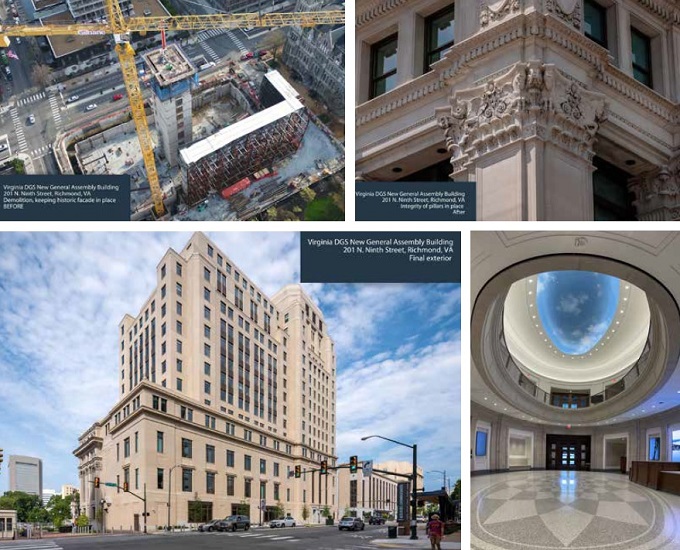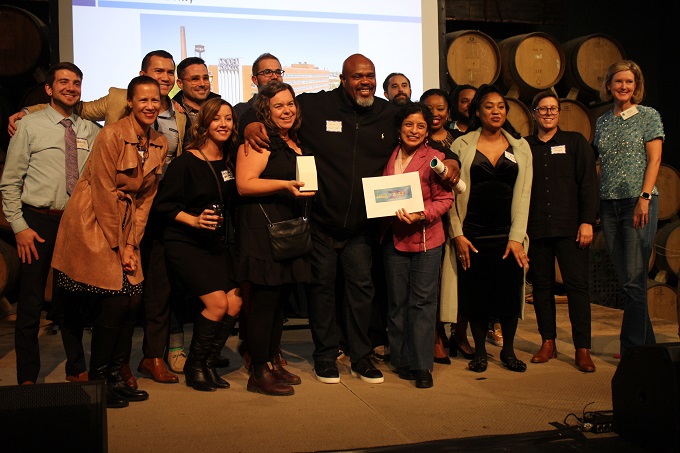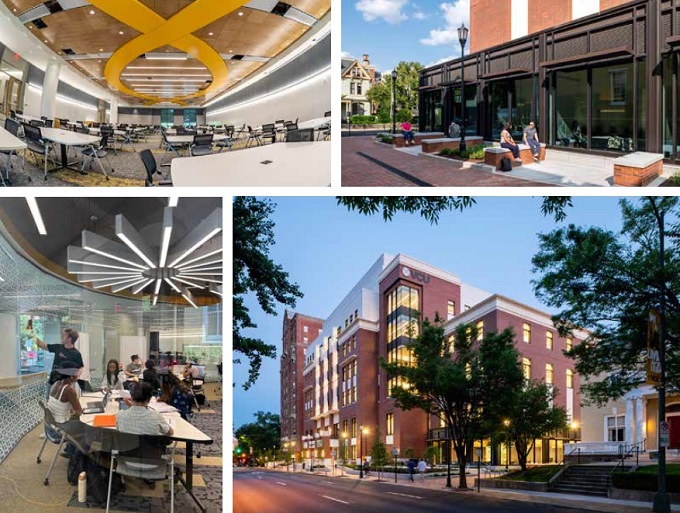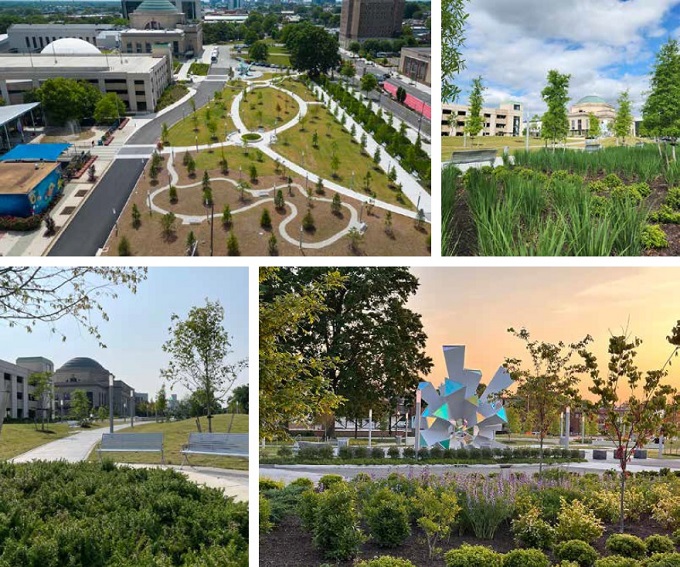
The Old City Hall building, across Broad Street from the children’s hospital, was awarded the Golden Hammer for Best Restoration. (Michael Schwartz photo)
The new home for Virginia’s legislative offices and a restoration of the Old City Hall building next door were among the top honorees at this year’s Golden Hammer awards.
The annual awards honoring standout real estate projects in the region were presented Thursday night by nonprofits Historic Richmond and Storefront for Community Design. A total of 14 awards were presented from among 48 nominees in a ceremony held at Hardywood Richmond.
The night’s big winner was the new General Assembly Building at 201 N. Ninth St., which received the Best Overall award. The nearly $300 million, 14-story tower near the Virginia State Capitol was developed by the Virginia Department of General Services, which worked with primary architect Robert A.M. Stern Architects, out of New York, and contractor Gilbane Building Co.

Photos show construction and architectural features of the new General Assembly Building at Ninth and Broad streets. (Images courtesy Historic Richmond)
Also on the project were architects Glave & Holmes Architecture and Wiss, Janney, Elstner Associates; engineers VHB, Dewberry and Robert Silman Associates; and Atlantic Refinishing & Restoration and Allen Architectural Metals.
Next door, the Old City Hall building at 1001 E. Broad St. was recognized in the Best Restoration category. Likewise owned by Virginia DGS, the restored granite building dating to 1894 also was awarded a teens’ choice award by Storefront’s City Builders design workshop participants.
DGS worked on the restoration with designer and landscape architect Quinn Evans; engineers Dunlap & Partners, Draper Aden Associates and Silman; contractor Grunley; and consultants GHD, Vertran Enterprises and Gary Steffy Lighting Design.
Another double-winner Thursday was Better Housing Coalition, which was recognized for its The Planet Apartments in Jackson Ward, and for three dozen for-sale homes it developed at the Armstrong Renaissance development in Richmond’s East End.
The 67-unit Planet Apartments at 107 W. Duval St. was awarded Best New Construction in the residential category. In addition to the coalition, project team members included Baskervill (architect, interiors, MEP engineering), engineers Timmons Group and Simpson Gumpertz & Heger, and contractor UrbanCore Construction.
Best New Construction in the single-family residential ownership category went to North Hills at Armstrong Renaissance, the coalition’s 36 for-sale homes at the 22-acre Armstrong Renaissance development. Team members included architect Residential Design Services, engineer Timmons Group and contractor Eagle Construction of VA.
Best New Construction in the civic category went to VCU’s STEM building at 817 W. Franklin St. Team members included Quinn Evans (architect and landscape architect), Ballinger (architect and engineer), engineers Draper Aden Associates and Columbia Engineering, and contractor Hourigan.
Best Adaptive Reuse went to Model Tobacco Lofts, C.A. Harrison Cos.’ conversion of the 1939 Art Deco-style former tobacco factory at 1100 Richmond Highway into 200-plus apartments. Project team members included Walter Parks Architects, Timmons Group (civil engineer and landscape architect), MEP engineer ONeil Engineering Services, contractor Mark Turner Construction, and tax credit consultant Sadler & Whitehead.
Two additional Golden Hammers were presented in the adaptive reuse category. Sauer Properties’ conversion of retail space at Willow Place shopping center for River City Veterinary Hospital was recognized for “Vision for Commercial Vitality,” while 1513 Rear Grove Ave., a residential conversion by owner-developer Ron Nixon of a 1910 auto repair garage in the Fan, was recognized for “Quality in Innovation & Design.”
Best Rehabilitation went to 4015 Fitzhugh Ave., a renovation of the former Virginia Mutual Insurance Co. and Boy Scouts of America building into new offices for architecture firm 3North, which designed the project and also was the landscape architect. Other firms involved were owner-developer VA Wood Properties, Lu+Smith Engineers and contractor Whiting-Turner.
Best Placemaking and Urban Design went to The Green, the Science Museum of Virginia’s green space project at 2500 W. Broad St. Glave & Holmes was the project architect, Daniel & Co. was the contractor, and VHB was the engineer and landscape architect along with HG Design Studio.
Best Placemaking–Arts/Engagement went to the community center building at Bermuda Estates, a manufactured home park in Chester owned by Project:Homes. The housing nonprofit was the developer and worked on the building with architect Form Coalition, engineer Blue Nest Structural and civic group Virginia Community Voice.
Three awards were presented in the Best Single-Family Residential Rehab category: to owner Gray Montrose’s Taquitock Farm at 4300 Eanes Lane; Jon and Tracey Heckel’s John Morris Cottage at 207 N. 25th St. (with Apex Construction Solutions and others); and Brent Evans’ Patterson-Schutte House at 5613 Kildare Drive (with Creative Touch Painting and Hankla Masonry).

Developer Chris Harrison, center, and the team behind Model Tobacco Lofts celebrate their award at Thursday’s ceremony, alongside Historic Richmond Executive Director Cyane Crump, right. (Jonathan Spiers photo)
More on the award winners and nominees can be found here.
Judging the awards were Kim Chen with the City of Richmond, Historic Richmond Executive Director Cyane Crump, Community Foundation for a greater Richmond’s Gregory Gallop, Storefront for Community Design’s Stephanie Golembeski, Better Housing Coalition CEO Greta Harris, Modern Richmond co-founder Andrea Levine, Baskervill Chairman Burt Pinnock, Richmond Memorial Health Foundation’s Albert Walker III, and VCUarts’ Camden Whitehead.

The Old City Hall building, across Broad Street from the children’s hospital, was awarded the Golden Hammer for Best Restoration. (Michael Schwartz photo)
The new home for Virginia’s legislative offices and a restoration of the Old City Hall building next door were among the top honorees at this year’s Golden Hammer awards.
The annual awards honoring standout real estate projects in the region were presented Thursday night by nonprofits Historic Richmond and Storefront for Community Design. A total of 14 awards were presented from among 48 nominees in a ceremony held at Hardywood Richmond.
The night’s big winner was the new General Assembly Building at 201 N. Ninth St., which received the Best Overall award. The nearly $300 million, 14-story tower near the Virginia State Capitol was developed by the Virginia Department of General Services, which worked with primary architect Robert A.M. Stern Architects, out of New York, and contractor Gilbane Building Co.

Photos show construction and architectural features of the new General Assembly Building at Ninth and Broad streets. (Images courtesy Historic Richmond)
Also on the project were architects Glave & Holmes Architecture and Wiss, Janney, Elstner Associates; engineers VHB, Dewberry and Robert Silman Associates; and Atlantic Refinishing & Restoration and Allen Architectural Metals.
Next door, the Old City Hall building at 1001 E. Broad St. was recognized in the Best Restoration category. Likewise owned by Virginia DGS, the restored granite building dating to 1894 also was awarded a teens’ choice award by Storefront’s City Builders design workshop participants.
DGS worked on the restoration with designer and landscape architect Quinn Evans; engineers Dunlap & Partners, Draper Aden Associates and Silman; contractor Grunley; and consultants GHD, Vertran Enterprises and Gary Steffy Lighting Design.
Another double-winner Thursday was Better Housing Coalition, which was recognized for its The Planet Apartments in Jackson Ward, and for three dozen for-sale homes it developed at the Armstrong Renaissance development in Richmond’s East End.
The 67-unit Planet Apartments at 107 W. Duval St. was awarded Best New Construction in the residential category. In addition to the coalition, project team members included Baskervill (architect, interiors, MEP engineering), engineers Timmons Group and Simpson Gumpertz & Heger, and contractor UrbanCore Construction.
Best New Construction in the single-family residential ownership category went to North Hills at Armstrong Renaissance, the coalition’s 36 for-sale homes at the 22-acre Armstrong Renaissance development. Team members included architect Residential Design Services, engineer Timmons Group and contractor Eagle Construction of VA.
Best New Construction in the civic category went to VCU’s STEM building at 817 W. Franklin St. Team members included Quinn Evans (architect and landscape architect), Ballinger (architect and engineer), engineers Draper Aden Associates and Columbia Engineering, and contractor Hourigan.
Best Adaptive Reuse went to Model Tobacco Lofts, C.A. Harrison Cos.’ conversion of the 1939 Art Deco-style former tobacco factory at 1100 Richmond Highway into 200-plus apartments. Project team members included Walter Parks Architects, Timmons Group (civil engineer and landscape architect), MEP engineer ONeil Engineering Services, contractor Mark Turner Construction, and tax credit consultant Sadler & Whitehead.
Two additional Golden Hammers were presented in the adaptive reuse category. Sauer Properties’ conversion of retail space at Willow Place shopping center for River City Veterinary Hospital was recognized for “Vision for Commercial Vitality,” while 1513 Rear Grove Ave., a residential conversion by owner-developer Ron Nixon of a 1910 auto repair garage in the Fan, was recognized for “Quality in Innovation & Design.”
Best Rehabilitation went to 4015 Fitzhugh Ave., a renovation of the former Virginia Mutual Insurance Co. and Boy Scouts of America building into new offices for architecture firm 3North, which designed the project and also was the landscape architect. Other firms involved were owner-developer VA Wood Properties, Lu+Smith Engineers and contractor Whiting-Turner.
Best Placemaking and Urban Design went to The Green, the Science Museum of Virginia’s green space project at 2500 W. Broad St. Glave & Holmes was the project architect, Daniel & Co. was the contractor, and VHB was the engineer and landscape architect along with HG Design Studio.
Best Placemaking–Arts/Engagement went to the community center building at Bermuda Estates, a manufactured home park in Chester owned by Project:Homes. The housing nonprofit was the developer and worked on the building with architect Form Coalition, engineer Blue Nest Structural and civic group Virginia Community Voice.
Three awards were presented in the Best Single-Family Residential Rehab category: to owner Gray Montrose’s Taquitock Farm at 4300 Eanes Lane; Jon and Tracey Heckel’s John Morris Cottage at 207 N. 25th St. (with Apex Construction Solutions and others); and Brent Evans’ Patterson-Schutte House at 5613 Kildare Drive (with Creative Touch Painting and Hankla Masonry).

Developer Chris Harrison, center, and the team behind Model Tobacco Lofts celebrate their award at Thursday’s ceremony, alongside Historic Richmond Executive Director Cyane Crump, right. (Jonathan Spiers photo)
More on the award winners and nominees can be found here.
Judging the awards were Kim Chen with the City of Richmond, Historic Richmond Executive Director Cyane Crump, Community Foundation for a greater Richmond’s Gregory Gallop, Storefront for Community Design’s Stephanie Golembeski, Better Housing Coalition CEO Greta Harris, Modern Richmond co-founder Andrea Levine, Baskervill Chairman Burt Pinnock, Richmond Memorial Health Foundation’s Albert Walker III, and VCUarts’ Camden Whitehead.







I kind of thought Old City hall was known for having a vivid, very busy interior color scheme? Not to nitpick – they can always repaint some day – but was all the red/gold/blue/green that I’ve seen in old photos not original? It looks so austere inside in these photos
The multi color paint scheme was from the 1980s. This is historically accurate.
Yes, the 1980s scheme had no historical basis. The new restoration brings more attention to the original architectural details instead of the garish 1980s paint scheme and makes the atrium much brighter.
I wasn’t entirely certain. Was that… trendy…?…in the 80s? I never had the chance to take a tour of the building, I’ve only seen photos, just remember how startling the colors were,
The eighties…. well, that was when historic renovation really started taking off — before that, the cool thing to do was to tear down old blgds, because, you know, old = yuck, or that was what the purveyors of midcentury modern were pushing.
To be fair, many Victorian Era interiors actually WERE that garish (due to the then-recent invention of mass-produced paint pigments). See, e.g. the Crossness Pumping Station, which resembled the old painted interior very much, as well as Ruskin’s work. I think the 1980s scheme highlighted the details much better (and was part of the broader Victorian Revival of the 1970s-1990s, its own delightful phenomenon). IMHO, the two-tone scheme looks like cheap molded plastic, or at the most cheap plasterwork. I think in this case, “historically accurate” (assuming it actually is) is less effective than “the best we can make it”.… Read more »
Thanks for this — taste is a funny thing, esp when you study the history of taste. Yes, “accurate” can be quite garish, among other things that are not always agreed to be the best. People romantacise classical archetecture, but I don’t think Thomas Jefferson or the French seemed to know that all those bleach white columns were just deceptive artifacts — the Romans et al painted a lot of things with deep pigment that we often find a bit too rich these days — I prefer the austere look —- much of what was fancy in the past was… Read more »
Salas O’Brien was so honored to have been a part of the restoration of the beautiful Historic Old City Hall.
Wow! I didn’t know the Richmond Housing development of the Armstrong site was so nice!!!